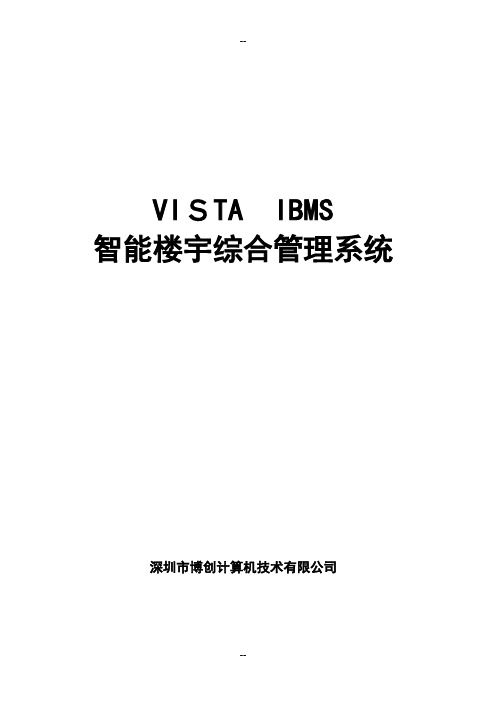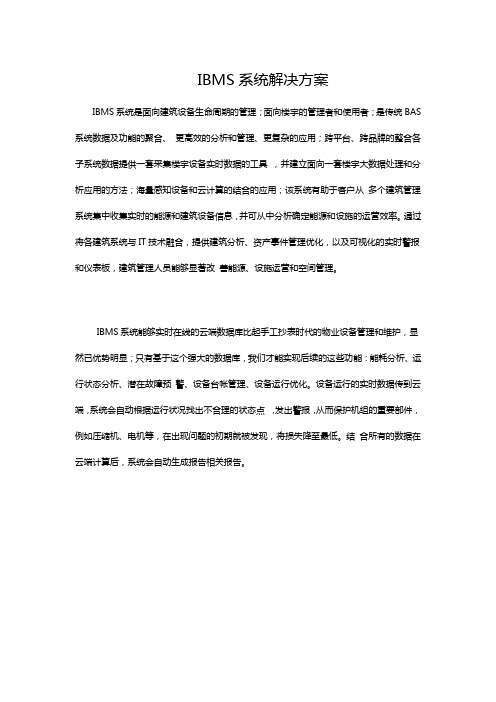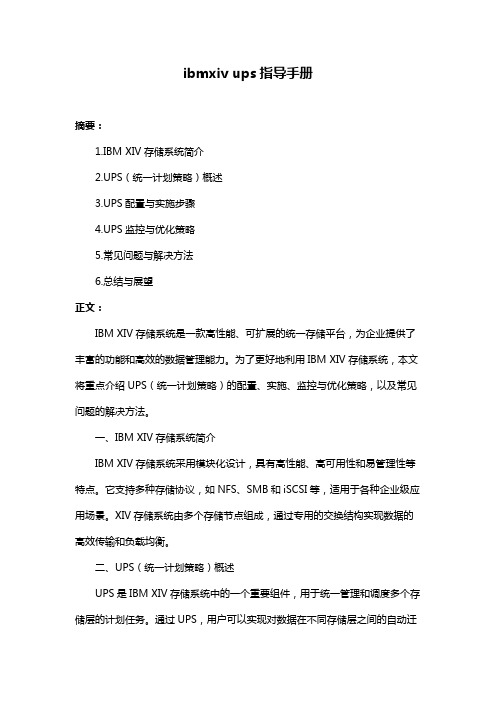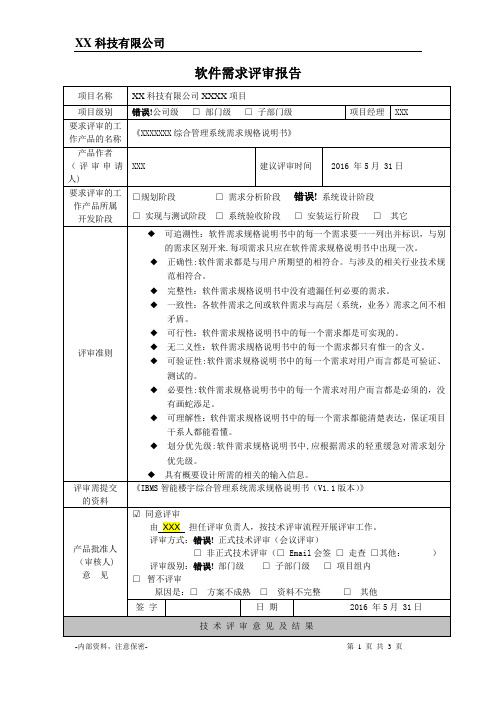IBMS系统需求说明书系统V
智能化集成管理系统IBMS全面需求书

第1章智能化集成管理系统1.1.系统概述智能化集成管理系统是将不一样功能旳建筑智能化系统,通过统一旳信息平台实现集成,以形成具有信息汇集、资源共享及优化管理等综合功能旳系统。
本项目旳智能化集成管理系统是通过统一旳软件平台,实现对防灾报警、建筑设备管理、车位引导等系统进行集成,并与广播系统、视频安防监控系统、出入口控制系统、信息公布系统互联,提高综合管理水平。
智能化集成管理系统软件平台必须建立在不依赖于硬件设备旳分布式软件系统平台之上,构成系统旳软件部件应可以按照详细项目旳硬件配置进行布署;同步,应具有良好开放性和与大规模监控系统相适应旳软件构架,丰富旳数据和通信接口,并可以根据工程规定,扩展开发新旳数据和通信接口,可以与其他机电设备系统实现信息互通。
1.2.工程范围本项目旳智能化集成系统集成旳范围包括如下子系统:建筑设备监控系统、公共安全防备系统(包括门禁、视频安防监控系统,电子巡查管理系统,停车场管理系统)、火灾自动报警系统、背景音乐及紧急广播系统、机房动力环境监控系统、信息引导及公布系统等。
1.3.系统建设目标智能化集成系统作为本项目工程项目中智能化设备运行信息旳交汇与处理旳中心,对汇集旳各类信息进行分析、处理和判断,采用最优化旳控制手段,对各设备进行分布式监控和管理,使各子系统和设备一直处在有条不紊、协调一致旳高效、经济旳状态下运行,最大程度地节省能耗和平常运行管理旳各项费用,保证各系统能得到充分、高效、可靠旳运行,并使各项投资可以给业主带来较高旳回报率。
1)集中管理:对各子系统进行全局化旳集中统一式监视和管理,将各集成子系统旳信息统一存储、显示和管理在智能化集成统一平台上。
精确、全面地反应各子系统运行状态,并能提供建筑关键场所旳各子系统综合运行汇报,提高突发事件旳响应能力。
与控制系统有关旳全局事件:当某些事件发生后,系统中多种控制系统做出反应,详细体目前子系统旳联动上。
如:安防联动、消防联动、重要设备突发故障旳全系统联动。
(完整版)IBMS简介

可以直接调看相关弱电系统的报警信息,及 该报警信息相关的设备的图纸及文档。
信息查询
通过IBMS工作站可以查询所有与物业有关的资料,浏览 各种物业的总体情况和详细资料,包括建筑群中建筑分 布图、建筑平面图、 水、电、气等配套设施的安装、使 用和维修情况等,
➢对于不同的子系统提供统一统都以电子地图方式显示。
2. 控制功能 ➢ 系统中的授权用户可以对自己有权限的设备进行控制。 ➢ 为不同控制系统提供统一的、WEB方式的控制界面
个子系统.
为何需要IBMS集成系统?
提供开放式的集成系统平台 集成多种智能控制系统 提供中央数据由不同系统共享 为不同控制系统提供统一控制界面 简化界面操控程序流程 为不同系统提供统一故障管理 未来项目不限制与任何楼控产品作准备 为未来项目的维护及改造成本节约作准备 使系统信息传输更有效率,建筑智能系统可有效分配资源 达到最有效率能源管理及节能 使管理建筑人力资源达到最高效率
根据弱电系统运行情况定期生成设备维护通知单、 日常工作日志等统计报表。
对楼宇控制系统和电力监控系统记录的水、电、制 暖、制冷量,进行统计,根据用户单位,产生相 应的报表。
系统预留与财务系统的通信接口,可将上述统计结 果发送给财务系统。
信息管理
采用标准的SQL数据库软件,在各个建筑物内 部子系统信息集成的基础上,对所有物业 的文档资料进行全面管理,存档备查,包 括录入和系统维护的各种数据信息,如各 子系统的图片资料、平面结构、建筑说明、 装修情况、使用情况等。
IBMS系统集成的趋势
结合最新IT科技 摆脱传统采用楼控系统集成的限制 分散风险系统设计理念 更有效的发挥弱电系统应有的功能 以业主的具体需求为系统设计基础 以人为本的设计 创造更加人性化的使用界面 开放式系统架构便于将来的提升及扩建
IBMS智能楼宇综合管理系统

VISTA IBMS智能楼宇综合管理系统深圳市博创计算机技术有限公司VISTA IBMS智能楼宇综合管理系统一总述1ﻩ二设计目标 .............................................................................................................................................. 22.1设计原则ﻩ32.1.1开放性3ﻩ2.2.2 标准化和结构化 (3)2.2.3 模块化3ﻩ2.2.4 互连性ﻩ32.2.5 可管理性 (4)2.2.6先进性 (4)2.2.7 经济性 (4)2.2.8高效率 (4)2.2.9 可靠性 (4)2.2系统功能 (5)2.2.1集成各种子系统5ﻩ2.2.2远程监控 (5)2.2.3WEB信息发布 (5)2.2.4ODBC数据库连接5ﻩ2.2.5 电话语音查询6ﻩ2.2.6集成视频监控6ﻩ2.3设计标准6ﻩ三系统结构8ﻩ3.1网络结构 (8)3.2报警方案10ﻩ3.3软件结构 (11)3.3.1 B/S构架 (12)3.3.2三层结构12ﻩ3.3.3 核心决策层ﻩ143.3.4 通讯接口层 (15)3.3.5用户界面层 (16)3.3.6 视频集成17ﻩ3.3.7 集成开发环境ﻩ193.3.8基于WEB的办公自动化系统........................................................................................... 203.3.9 异种操作系统和组件模型20ﻩ四楼宇子系统 (21)4.1集成楼宇自控系统 (22)4.2集成火灾报警系统2ﻩ44.3集成出入控制系统 (25)4.4集成闭路电视监视系统2ﻩ74.5集成停车场管理系统29ﻩ4.6集成广播音响系统ﻩ304.7集成电梯系统ﻩ314.8集成通讯自动化系统 (32)4.9集成办公自动化系统 .................................................................................................................. 33五安全性及实时性............................................................................................................................... 375.1安全性 (37)5.2实时性........................................................................................................................................... 385.3网络负荷 . (39)六系统管理39ﻩ6.1系统运行日志3ﻩ96.2系统配置ﻩ406.3报警排表41ﻩ6.4定时任务 (42)6.5联动 (43)6.6短信息双向互动4ﻩ4七系统特点45ﻩ八软件平台优势..................................................................................................................................... 47九系统软件选型4ﻩ9一总述智能楼宇管理系统(IBMS)是通过统一的软件平台对建筑物内的设备进行自动控制和管理并对用户提供信息和通信服务,住户可以对建筑物的所有空调、给水排水、供配电设备、防火、保安设备等进行综合监控和协调。
标准系统集成管理系统(IBMS)

IBMS集成一、概述现代化的智能化楼宇管理系统(IBMS)是以建筑物群为单位,通过当代计算机及先进的通讯技术,对建筑物的空调设备、排给水设备、供配电设备、通风、消防、保安设备等进行综合监控管理,为管理者提供一个直观便捷的操作平台,从根本上为企业提高管理效率,降低能源损耗,从而达到节能减排的目的,这也符合国家“低碳生活,节能减排”的要求。
二、IBMS的优势及益处目前许多大厦都在利用科技手段提高其管理效率,楼宇自控系统、保安监控系统、消防报警系统、门禁一卡通系统、电子巡更系统、广播系统、信息发布系统、紧张呼叫系统等,显然,这些系统的确可以为大厦的日常管理带来许多便利,一定程度上减少了人工维护的成本和效率,但是,与此同时我们也会发现,当使用越多的不同的系统,就需要配备越多的管理人员与之对应或者管理员需要不停地登陆不同的系统进行管理,这样无形中也让后勤的管理人员加大了工作量和降低时效,甚至可以发现,所有的系统都是各自运作,互不关联,因此只是形式上把大厦的管理电子化,而没有真正达到优化管理的目的。
虽然大厦已经使用了各种科技手段辅助管理,但却是很零散的“破碎化”管理,各系统分散、独立、互不关联,无法集中管理,因此,作为专门提供统一管理的智能化楼宇管理系统(IBMS)可以很好地把各子系统有机关联,进行数据交互。
IBMS不是对其它子系统功能与界面的简单重复,也不是对子系统的所有配置的简单拷贝,而是将整个智能中心监控及管理所需的重要信息综合起来,通过对各被集成子系统的信息的整合,生成智能中心运行管理所必须的综合信息数据库,提供给智能中心的物业管理部门及业主,从而对所有全局事件进行集中管理,进而为综合性全局决策提供依据。
同时,IBMS的另一个重要的作用,是将所有子系统之间需要共享的数据收集上来,存储到统一的开放式关系数据库当中,使各个本来毫不相关的子系统,可以在统一的IBMS 平台上互相对话,实现互联互通,因此实现了统一的向上集成,一旦某个子系统出现报警,其他所有相关子系统均可以从IBMS 中央数据库中得到该报警信息,并按照系统预先设置的联动方法进行联动,使各个系统的功能可以互相配合。
IBMS管理平台集成各子系统功能说明,含15个弱电系统

IBMS集成管理平台已经成为了弱电项目中标配,也算是一个智能化项目的亮点,众多弱电系统统一管理,进行系统之间的联动与配合,既可以节省人力成本,也能提高智能化响应速度。
那么IBMS管理平台集成各个弱电系统的功能是怎么样的呢?一起来看看吧!IBMS管理平台集成各子系统功能(图中所配置的图片仅供参考学习)1、视频监控系统视频监控系统提供数字监控平台的通信控制协议并开放平台的控制接口、提供网络SDK开发包(带云台控制)给智能化集成系统。
智能化集成系统可以以电子地图和菜单方式管理所有的摄像机、报警设备;接收其它系统的报警信息并进行相应的联动;从窗口中观察实时动态信息,如监控图像等。
当其它子系统因报警等原因需要电视监控系统的相应动作时,集成管理系统将使视频监控系统快速、准确地完成相应的功能,如画面切换、预制位等功能。
用户经过授权均可实时查看视频图像。
➢视频监控系统提供每个摄像头点位的平面分布图。
➢智能化集成系统可以以电子地图和菜单等多种方式管理所有的摄像机。
➢智能化集成系统可以实现从监控工作站的电子地图窗口中点击摄像头调出实时动态监控的图像;➢在视频监控系统提供矩阵控制协议和网络SDK开发包(带云台控制)的情况下,智能化集成系统实现带云台摄像机的控制、俯仰及变焦对焦等功能。
➢智能化集成系统可以实现对每个摄像机进行联动配置,在接收到其它系统的报警信息的同时进行相应的联动;如:可实现与防盗及紧急报警系统、照明系统、门禁系统之间的联动要求:1)监控系统与防盗报警系统联动:防盗报警系统出现报警信息,集成平台弹出报警区域的视频图像画框,工作上人员能及时确认警情,上报安保部门,以便报警事务的确认及紧急处理。
2)监控系统与门禁系统联动:重要位置实现门禁系统与视频监控的联动,当特殊区域门禁开启,集成平台联动视频监控系统,切换相应位置摄像机画面至规定的监视屏幕。
3)报警信息及系统操作动作信息实施存储以便后期查询调用,同时平台可生成打印报表,以便相关人员使用。
IBMS系统解决方案

IBMS系统解决方案IBMS系统是面向建筑设备生命周期的管理;面向楼宇的管理者和使用者;是传统BAS 系统数据及功能的聚合、更高效的分析和管理、更复杂的应用;跨平台、跨品牌的整合各子系统数据提供一套采集楼宇设备实时数据的工具,并建立面向一套楼宇大数据处理和分析应用的方法;海量感知设备和云计算的结合的应用;该系统有助于客户从多个建筑管理系统集中收集实时的能源和建筑设备信息,并可从中分析确定能源和设施的运营效率。
通过将各建筑系统与IT技术融合,提供建筑分析、资产事件管理优化,以及可视化的实时警报和仪表板,建筑管理人员能够显著改善能源、设施运营和空间管理。
IBMS系统能够实时在线的云端数据库比起手工抄表时代的物业设备管理和维护,显然已优势明显;只有基于这个强大的数据库,我们才能实现后续的这些功能:能耗分析、运行状态分析、潜在故障预警、设备台帐管理、设备运行优化。
设备运行的实时数据传到云端,系统会自动根据运行状况找出不合理的状态点,发出警报,从而保护机组的重要部件,例如压缩机、电机等,在出现问题的初期就被发现,将损失降至最低。
结合所有的数据在云端计算后,系统会自动生成报告相关报告。
IBMS系统可以在线监控设备的运行参数并对设备的诊断分析,通过对设备运行参数和设计参数以及历史数据的比对,评估设备潜在的风险,实现对设备故障的原因分析,帮助用户规避风险,提出运行和保养维修建议,给出系统节能优化方案,最大限度的帮助客户节省费用。
1、方案概述智能建筑管理系统(简称IBMS)是智能大厦的一个重要的组成部分。
以当今先进的网络技术、计算机技术、通信技术、控制技术和数据处理技术等多项技术为基础的,通过网络将各个子系统连接起来,共同完成集中操作、管理和分散控制功能。
IBMS解决方案将建筑自动化系统(BAS)、消防系统(FAS)、安防系统等各子系统进行集中管理。
主要是对楼宇中的空调系统、冷热源系统、给排水系统、电力、灯光照明、电梯、消防及保安系统等众多分散设备的运行、安全状况统一进行集中监视、管理和分散控制。
标准系统集成管理系统(IBMS)

IBMS集成一、概述现代化的智能化楼宇管理系统(IBMS)是以建筑物群为单位,通过当代计算机及先进的通讯技术,对建筑物的空调设备、排给水设备、供配电设备、通风、消防、保安设备等进行综合监控管理,为管理者提供一个直观便捷的操作平台,从根本上为企业提高管理效率,降低能源损耗,从而达到节能减排的目的,这也符合国家“低碳生活,节能减排”的要求。
二、IBMS的优势及益处目前许多大厦都在利用科技手段提高其管理效率,楼宇自控系统、保安监控系统、消防报警系统、门禁一卡通系统、电子巡更系统、广播系统、信息发布系统、紧张呼叫系统等,显然,这些系统的确可以为大厦的日常管理带来许多便利,一定程度上减少了人工维护的成本和效率,但是,与此同时我们也会发现,当使用越多的不同的系统,就需要配备越多的管理人员与之对应或者管理员需要不停地登陆不同的系统进行管理,这样无形中也让后勤的管理人员加大了工作量和降低时效,甚至可以发现,所有的系统都是各自运作,互不关联,因此只是形式上把大厦的管理电子化,而没有真正达到优化管理的目的。
虽然大厦已经使用了各种科技手段辅助管理,但却是很零散的“破碎化”管理,各系统分散、独立、互不关联,无法集中管理,因此,作为专门提供统一管理的智能化楼宇管理系统(IBMS)可以很好地把各子系统有机关联,进行数据交互。
IBMS不是对其它子系统功能与界面的简单重复,也不是对子系统的所有配置的简单拷贝,而是将整个智能中心监控及管理所需的重要信息综合起来,通过对各被集成子系统的信息的整合,生成智能中心运行管理所必须的综合信息数据库,提供给智能中心的物业管理部门及业主,从而对所有全局事件进行集中管理,进而为综合性全局决策提供依据。
同时,IBMS的另一个重要的作用,是将所有子系统之间需要共享的数据收集上来,存储到统一的开放式关系数据库当中,使各个本来毫不相关的子系统,可以在统一的IBMS 平台上互相对话,实现互联互通,因此实现了统一的向上集成,一旦某个子系统出现报警,其他所有相关子系统均可以从IBMS 中央数据库中得到该报警信息,并按照系统预先设置的联动方法进行联动,使各个系统的功能可以互相配合。
商户管理系统方案说明书V15

商户管理系统方案说明书V15商户管理系统方案说明书V15一、引言随着全球信息化时代的到来,越来越多的商户意识到需要通过有效的管理系统来提高运营效率、降低成本、增强市场竞争力。
为此,我们专门设计了一款商户管理系统方案,旨在帮助商户实现全方位的业务管理。
本说明书将详细介绍该系统的功能和使用方法。
二、系统概述商户管理系统方案由多个模块组成,包括基础管理、业务管理、数据分析等部分。
整个系统采用分布式架构,具备良好的可扩展性和稳定性,能够满足不同商户的需求。
1、基础管理模块:包括用户注册、权限分配、角色管理等,主要用于支撑系统的日常运营。
2、业务管理模块:涵盖商品管理、订单处理、库存管理等功能,帮助商户实现业务自动化。
3、数据分析模块:通过对商户各类数据进行分析,为决策提供有力支持。
三、功能特点1、用户注册:系统提供便捷的用户注册功能,用户只需填写必要的个人信息即可。
2、权限分配:管理员可根据角色或用户需求,分配相应的系统权限,确保系统安全。
3、商品管理:支持商户对商品进行详细分类、属性设置等管理,便于库存和销售查询。
4、订单处理:系统自动处理订单状态,支持多种支付方式,提高订单处理效率。
5、库存管理:实时监控商品库存情况,提醒管理员进行补货或调整库存策略。
6、数据报表:提供各类数据报表,帮助商户分析业务情况,为决策提供数据支持。
四、使用流程1、用户注册:用户填写必要信息,完成注册。
2、信息录入:管理员根据业务需求,录入商品信息、订单信息等。
3、数据处理:系统自动处理数据,生成相应的报表和分析报告。
4、策略调整:根据数据分析结果,管理员调整经营策略,提高业务效率。
五、系统优势1、提高效率:通过自动化处理订单和库存管理,减少人力成本,提高运营效率。
2、降低成本:有效的数据分析能够降低库存成本和运营成本,提高利润率。
3、增强市场竞争力:通过精细化的业务管理和数据支持,提高商户的市场竞争力。
六、应用场景1、商业零售:适用于各类零售店,如便利店、超市、百货店等。
IBM 系统存储 XIV 系统产品说明说明书

I B M X I V®S t o r a g e S y s t e m Performance ReinventedW h i t e P a p e rSeptember 2008Copyright IBM Corporation 2008IBM, the IBM logo, , System Storage, XIV, and the XIV logo are trademarks or registered trademarks of International Business Machines Corporation in the United States, other countries, or both These and other IBM trademarked terms are marked on their first occurrence in this information with the appropriate symbol (® or ™), indicating US registered or common law trademarks owned by IBM at the time this information was published. Such trademarks may also be registered or common law trademarks in other countries. A current list of IBM trademarks is available on the Web at /legal/copytrade.shtml .Other company, product, or service names may be trademarks or service marks of others.This document could include technical inaccuracies or typographical errors. IBM may not offer the products, services or features discussed in this document in other countries, and the product information may be subject to change without notice. Consult your local IBM business contact for information on the product or services available in your area. Any statements regarding IBM’s future direction and intent are subject to change or withdrawal without notice, and represent goals and objectives only. The information contained in this document is current as of the initial date of publication only and is subject to change without notice. All performance information was determined in a controlled environment. Actual results may vary. Performance information is provided “AS IS” and no warranties or guarantees are expressed or implied by IBM. Information concerning non-IBM products was obtained from the suppliers of their products, their published announcements or other publicly available sources. Questions on the capabilities of the non-IBM products should be addressed with the suppliers. IBM does not warrant that the information offered herein will meet your requirements or those of your distributors or customers. IBM provides this information “AS IS” without warranty. IBM disclaims all warranties, express or implied, including the implied warranties of noninfringement, merchantability and fitness for a particular purpose or noninfringement. IBM products are warranted according to the terms and conditions of the agreements under which they are provided.*******************ContentsIntroduction (1)The XIV System: Architecture and Performance (1)Optimal Exploitation of All System Resources (1)Integrating Cache and Disk in Each Module (2)Huge CPU Power (2)High Performance without Management Effort (2)High Performance with Snapshots (2)Disk Mirroring vs. Parity-based Protection (3)Maintaining Performance Consistency through Failures (5)Traditional storage: Degradation during the Rebuild Process (5)Traditional storage: Degradation Due to Write-through Mode (5)The XIV System: Performance in the Field (6)Scenario #1: Write-intensive Database (6)Scenario #2: E-mail Appliances (6)Scenario #3: Voice-recording Application (7)Scenario #4: E-mail Server (7)Summary (7)IntroductionOne of the major requirements of any SAN administration team is to provide users and applications with adequate performance levels. This task becomes increasingly difficult with demands for high performance growing while budgets for storage systems, administration efforts, and power consumption are diminishing.This document describes how the IBM® XIV™ Storage System provides an outstanding and in many ways unprecedented solution to today's performance requirements. It does so by achieving the following:►Providing high performance through a massively parallelized architecture, optimal exploitation of all system components (including disks, CPUs, andswitches), and an innovative cache design.►Ensuring that performance levels are kept intact when adding storage capacity, adding volumes, deleting volumes, or resizing volumes.►Guaranteeing the same performance level, even throughout variations of the applications' access patterns►Providing high performance without any planning or administration efforts►Providing consistent performance levels even through hardware failures►Maintaining high performance even while using snapshotsThe XIV System: Architecture and Performance Optimal Exploitation of All System ResourcesEach logical volume in the XIV system is divided into multiple stripes of one megabyte. These stripes are spread over all the disks in the system, using a sophisticated pseudo-random distribution mechanism.This revolutionary approach ensures that:►All disks and modules are utilized equally, regardless of access patterns.Despite the fact that applications may access certain volumes more frequently than other volumes or access certain parts of a volume more frequently than other parts, the load on the disks and modules remains balanced perfectly.►Pseudo-random distribution ensures consistent load balancing even after adding, deleting, or resizing volumes, as well as after adding or removinghardwareIntegrating Cache and Disk in Each ModuleUnlike traditional storage systems, the XIV system’s design embeds the read/write cache in the same hardware module as the disks. This unique design aspect has several advantages:►Distributed Cache. The cache is implemented as a distributed cache, so that all cache units can concurrently serve host I/Os and perform cache-to-disk I/O. This ensures that cache never becomes a bottleneck. In contrast, traditional storage systems use a central memory architecture, which has significant overhead due to memory locking.►High Cache-to-Disk Bandwidth. Aggressive prefetching is enabled by the fact that cache-to-disk bandwidth is the internal bandwidth of a module, providingdozens of gigabytes per second for the whole system.►Powerful Cache Management. Its unique cache design enables the XIV system to read a large cache slot per each disk read, while managing least-recently-used statistics in small cache slots. This unique combination is made possible by the system’s huge processing power and high cache-to-disk bandwidth.Huge CPU PowerEach data module has its own quad-core processor, giving the XIV system dozens of CPU cores. The system uses this vast processing power to execute advanced caching algorithms that support small cache slots, enable powerful snapshot performance, and so on. The massive CPU power ensures high performance through high cache-hit rates and minimal snapshot overhead.High Performance without Management EffortUnlike other storage systems, the XIV system is fully virtualized. The user has no control over the allocation of volumes to physical drives. As a result, the XIV system's high performance is gained with no planning efforts. The user does not have to allocate volumes to specific disk drives or shelves, nor is there a need to reconsider these decisions when new volumes are required, new hardware is added, or application access patterns change.Instead, the XIV system always ensures optimal utilization of all resources in a way that is transparent to the hosts and storage administration team.High Performance with SnapshotsMany storage systems can provide the required performance levels as long as snapshots are not defined. This is because snapshot functionality was added to these systems long after their initial design. As soon as snapshots are defined, performance levels in many cases degrade to unacceptable levels. Some systems solve this problem by using full copies instead of differential snapshots.The XIV system has been designed from inception to support snapshots. Its combination of innovative replication algorithms and massive CPU and cache power keep the impact of snapshots on performance to a minimum. Specifically, it achieves this as follows:►The traditional copy-on-write technique is replaced by the more efficient redirect-on-write technique, eliminating unnecessary copies►Redirect-on-write is always performed within the same module where data is being copied between disks. This architecture provides a huge performanceboost compared with the traditional method of copying between modules.►Snapshot write overhead does not depend on the number of snapshots or volume size►Zero read overhead for volumes and snapshots►Zero overhead when writing in unformatted areasDisk Mirroring vs. Parity-based ProtectionToday’s storage administrators face the dilemma of deciding which protection scheme to choose for their data: mirroring or parity-based. The XIV system uses mirroring protection, in which each piece of data is written on two disks. When comparing the XIV system to other systems, keep in mind that the propose configurations of other systems often involve RAID-5 or even RAID-6 protections, which create several performance problems:►Each host write translates into two disk writes and two disk reads (or even three writes and three reads in RAID-6) compared to two disk writes in mirroring.►RAID-5/6-based rebuild time is much longer, hence extending the time of reduced performance due to disk rebuild whenever a disk fails.►With RAID-5/6, upon a rebuild, each read request to the failed area is served through multiple reads and computing an XOR, creating a huge performanceoverhead.The XIV system architecture is shown in the following diagram:Figure 1: XIV ArchitectureMaintaining Performance Consistency through FailuresIn many storage systems, even those considered tier-1, performance levels can degrade significantly upon a hardware failure. This is unacceptable in today's world, since a reduction in performance levels means, in many cases, downtime for the applications.This section shows how traditional architectures create performance degradation due to hardware problems and how the XIV system solves this problem.Traditional storage: Degradation during the Rebuild ProcessThe current, traditional storage implementation of redundancy involves a redundant disk group, either mirrored pairs of disks or RAID-5 disk groups. Each such group has a hot spare disk, which is used to rebuild the redundancy upon a failure.The enormous increase in disk capacity in recent years has not, unfortunately, been matched by an increase in disk bandwidth. As a result, disk rebuild time has increased to several hours, to as many as 15, depending on disk size and protection scheme. During this time, the system suffers from severe performance degradation due to the heavy I/O requirement of the rebuild process. Some systems offer a way to limit the resources allocated for a rebuild, thus ensuring more system performance, but wind up increasing rebuild time, thereby increasing exposure to double failure.The XIV system's disk failure protection scheme enables a distributed rebuild mechanism in which all disks participate. This ensures an extremely short rebuild time, 30 minutes for a 1 TB drive. Furthermore, the overhead of the rebuild process is minimal, since all disks participate in the rebuild and each disk only needs to rebuild a small portion. This ensures that performance levels at rebuild time remain intact. Another problem with a RAID-5 or RAID-6-based rebuild is that until the rebuild process is over, each request to read data from the failed disk must be served via multiple reads from all the disk groups and computing XOR. This creates a huge performance impact on serving read requests. The XIV system's mirrored protection ensures that even while a rebuild is in progress, read requests are served without any overhead.Traditional storage: Degradation Due to Write-through ModeModern redundant storage architectures require that each write command be written in two cache units before the host is acknowledged. Otherwise, a single failure in the cache module would create data loss. Furthermore, they require redundant protection of power supply to these cache units.Unfortunately, many storage architectures cannot guarantee protected cache after certain types of failures. A typical example is the failure of a cache module, which leaves the peer cache module exposed to a single failure. Another example is the failure of a UPS module, which makes the system vulnerable to power failures.The common solution to this problem is to use write-through mode, in which a host is acknowledged only after the information has been written to two disks and without using write-cache. This mode has a severe impact on performance and usually means a slowdown or stoppage of service to the application host. Unfortunately, it takes a technician’s visit to overcome such a problem.With the XIV system, write-through mode is never used. Even after the failure of a UPS unit or module, a write request is written to a cache in two different modules. The XIV System: Performance in the FieldThe performance of the XIV system has been proven in the field, demonstrating dramatic increases in comparison to other tier-1 storage systems. Several examples are given below.Scenario #1: Write-intensive DatabaseA leading bank was trying to contend with a performance-demanding application based on a 7 TB Oracle database with an extremely write-intensive I/O. The application practically failed when running on a leading tier-1 storage system. When migrated to another tier-1 storage system, equipped with 240 FC 146 GB 15K ROM drives, the application managed to provide an adequate performance level, but no more. Snapshots were not possible without compromising performance to unacceptable levels; as a result, backup procedures were complex and limited. Migrating the application to the XIV system gave the customer a dramatic increase in performance (for example, queries could now be performed in one-third of the time), while enabling the ongoing use of 28 differential snapshots. The gains were many: a much better response time to users, simplified physical backup procedures, and 28 levels of logical backup snapshots.Scenario #2: E-mail AppliancesTwo leading ISPs compared the XIV system against a well-known tier-1 system running POP e-mail storage for a group of e-mail appliances. The existing system required an independent interface card per each e-mail appliance, making the solution much more expensive and complex.The XIV system was able to handle five e-mail appliances on a single interface port, with no degradation in performance.Scenario #3: Voice-recording ApplicationA world leader in voice recording systems compared the XIV system with a system made up entirely of 146GB 15K RPM FC drives. The customer found that, with the XIV system, the same set of servers could support three times more clients (12,000 instead of 4,000), consequently reducing the total cost of the solution by an order of magnitude.Scenario #4: E-mail ServerA leading telecom company tested Microsoft® Exchange server performance on various storage systems and saw a striking gap between XIV and another leading tier-1 system. After sharing this information with that vendor’s top support engineers, the customer was told that since the Exchange metadata was spanned across only 18 disk drives, performance was limited. The customer asked the vendor to lay out the volume on more disk drives. The response was that doing so was technically impossible. This example illustrates how XIV’s ease of management provided real life high performance, while other vendors did not manage to exploit the full power of the physical components due to management limitations.SummaryAs presented above, the XIV system provides:►Unmatched performance levels, setting a new standard for SAN storage►High performance levels without manual planning or a configuration process►High performance levels that are consistently maintained, even upon hardware failure►Industry breakthrough: snapshots with high performance。
ibmxiv ups指导手册

ibmxiv ups指导手册摘要:1.IBM XIV存储系统简介2.UPS(统一计划策略)概述3.UPS配置与实施步骤4.UPS监控与优化策略5.常见问题与解决方法6.总结与展望正文:IBM XIV存储系统是一款高性能、可扩展的统一存储平台,为企业提供了丰富的功能和高效的数据管理能力。
为了更好地利用IBM XIV存储系统,本文将重点介绍UPS(统一计划策略)的配置、实施、监控与优化策略,以及常见问题的解决方法。
一、IBM XIV存储系统简介IBM XIV存储系统采用模块化设计,具有高性能、高可用性和易管理性等特点。
它支持多种存储协议,如NFS、SMB和iSCSI等,适用于各种企业级应用场景。
XIV存储系统由多个存储节点组成,通过专用的交换结构实现数据的高效传输和负载均衡。
二、UPS(统一计划策略)概述UPS是IBM XIV存储系统中的一个重要组件,用于统一管理和调度多个存储层的计划任务。
通过UPS,用户可以实现对数据在不同存储层之间的自动迁移、压缩和备份等操作,以降低存储成本、提高数据利用率。
UPS支持多种计划类型,如周期性、基于事件的和手动触发等,可根据企业需求进行灵活配置。
三、UPS配置与实施步骤1.登录XIV存储系统管理界面,进入UPS配置页面。
2.创建计划任务,设置任务名称、类型、触发条件等参数。
3.配置存储层,根据实际需求选择源存储层和目标存储层。
4.设置数据迁移规则,包括压缩、复制、迁移等操作。
5.配置UPS与备份系统的集成,实现数据备份与恢复。
6.测试计划任务,确保数据迁移和处理过程符合预期。
四、UPS监控与优化策略1.通过XIV存储系统管理界面,实时监控UPS计划的运行状态和进度。
2.分析UPS报告,了解计划任务的执行情况和存储空间的利用率。
3.根据实际情况调整计划任务参数,优化数据迁移策略。
4.定期评估UPS性能,确保系统稳定运行。
五、常见问题与解决方法1.问题:UPS计划任务无法正常执行。
软件需求评审报告、评审要点、评审准则

可追溯性:软件需求规格说明书中的每一个需求要一一列出并标识,与别的需求区别开来。每项需求只应在软件需求规格说明书中出现一次。
◆正确性:软件需求都是与用户所期望的相符合。与涉及的相关行业技术规范相符合。
◆完整性:软件需求规格说明书中没有遗漏任何必要的需求。
◆一致性:各软件需求之间或软件需求与高层(系统,业务)需求之间不相矛盾。
已实施
XXX、 年 月 日
缺陷修正
验证情况
验证结论:
验证通过
验证人签字
日 期
年 月 日
□ 非正式技术评审(□ Email会签 □ 走查 □其他: )
评审级别: 部门级 □ 子部门级 □ 项目组内
□暂不评审
原因是:□ 方案不成熟 □ 资料不完整 □ 其他
签 字
日 期
2016年5月31日
技 术 评 审 意 见 及 结 果
评审时间
自 年 月 日 时 至 年 月 日 时
评审
问答
记录
1、考虑用户同名情况,如何处理
软件需求评审报告
项目名称
XX科技有限公司XXXX项目
项目级别
公司级 □ 部门级 □ 子部门级
项目经理
XXX
要求评审的工作产品的名称
《XXXXXXX综合管理系统需求规格说明书》
产品作者
(评审申请人)
XXX
建议评审时间
年 月 日
要求评审的工作产品所属
开发阶段
□规划阶段□ 需求分析阶段 系统设计阶段
□ 实现与测试阶段 □ 系统验收阶段 □ 安装运行阶段□ 其它
建议整改完成时间
2016年6月2日
评审负责人签字
日 期
2016年5月31日
IBMS系统简介-最新资料

IBMS系统简介-最新资料IBMS系统简介: the financial center as an international armor class A intelligent mansion, tianhe financial center building control system adopts the Siemens DDC control equipment for building to provide the mechanical and electrical equipment intelligent management, for center to create A comfortable and harmonious, the energy saving of the business environment. It will be the center of according to nature and USES characteristics, the use of advanced and mature software technology and system integration technology, will all kinds of ba subsystem form an unified, connected, and coordinated linkage of integrated management system, realize high share of building integrated information. Its purpose is to focus on building each subsystem of surveillance, control and management, effectively improve the management level of building, convenient for the user to the building's comprehensive management.Keywords: many system integration; Multitasking management; High share1、系统可实现的目标① 基本满足业主及所委托咨询公司技术要求② 实现综合化的智能大厦服务和管理通过对大厦内的安保系统(门禁、红外报警、闭路电视)、消防报警系统(对独立设置的火灾报警系统实行二次监控)、各类机电设备、照明、电梯等进行监视与控制,将大厦内的空间、能源、物流环境通过信息流与人联系起来,进行综合控制和管理,实行一体化服务。
IBMS集成管理系统介绍

联动功能➢ 消防报警与楼宇自控系统的联动消防报警发生时 , 楼宇自动控制系统关闭通排风机, 打开通排烟机 , 关闭楼层动力总配电 , 将电梯自动停 放在一楼。➢ 消防报警与门禁系统的联动消防报警发生时 , 报警信息上传到IBMS分中心 , IBMS 分中心根据预先设定的规则 , 通过门禁系统打开或关 闭相应的通道门和房门。➢ 消防系统与闭路监控系统的联动消防报警发生时 , 报警信息上传到IBMS分中心,IBMS分中心根据数据库中消防点位和闭路监控系统的 摄像机的对应关系 , 控制闭路监控系统的切换到现场 附近的画面 , 并启动硬盘录象系统进行录象。
高效通过集中统一 的监控 , 降低监管操作的难度, 节约管理人力资源 。通过基于历史数据的统计分 析 、预测 , 优化设备运行方式 , 达到节能和延长 使用寿命效果。便捷使用统一 的管理平台 , 和B/S的架构 , 即便 于本地管理 , 可实现远程管理 。 同时可以为外部 服务对象提供开放性信息。
信息查询通过IBMS工作站可以查询所有与物业有关的资料 , 浏览 各种物业的总体情况和详细资料 , 包括建筑群中建筑分 布图、建筑平面图、 水、 电、气等配套设施的安装、使用和维修情况等,
远程管理采用了WEB Server /Browser模式 , 用户可以 通过拨号或Internet网登录到IBMS管理中心, 实现与本地监控工作站完全相同的操作。
二 、 IBMS系统提供了统一 的管 理操作平台 , 通过该平台对各机 电子系统进行统一监测 、控制和 管理; 实现跨子系统的联动; 提 供开放的数据接口 , 共享信息资源。
三 、 IBMS系统采用Web技术和Intranet技术 , 使用户在一个简明 的浏览器界面上 , 根据其分工和权 限 , 访问集成系统的不同功能模块, 完成各自的工作任务 。提高工作利率 , 降低运行成本。
软件需求评审报告

评审级别: 部门级 □ 子部门级 □ 项目组内
□暂不评审
原因是:□ 方案不成熟 □ 资料不完整 □ 其他
签 字
日 期
2016年5月31日
技 术 评 审 意 见 及 结 果
评审时间
自 2016年5月31日14时 至 2016年5月31日 18时
汇 总
一、缺陷识别
无缺陷
二、总体评价及建议
总体需求分析比较透彻、完善;但需求优先级,相关需求界面没有进行描述,要进行详细补充。
基本通过。
评审结论
□评审通过:工作产品合格,“无需修改”或“需要轻微修改但不必再审核”;
评审基本通过:工作产品基本合格,需要作少量修改,之后通过审核即可;
□评审不通过:工作产品不合格,需要作比较大的修改,之后必须重新对其评审。
◆划分优先级:软件需求规格说明书中,应根据需求的轻重缓急对需求划分优先级。
具有概要设计所需的相关的输入信息。
评审需提交
的资料
《IBMS智能楼宇综合管理系统需求规格说明书(V1.1版本)》
产品批准人
(审核人)
意 见
同意评审
由XXX担任评审负责人,按技术评审流程开展评审工作。
评审方式: 正式技术评审(会议评审)
◆可行性:软件需求规格说明书中的每一个需求都是可实现的。
◆无二义性:软件需求规格说明书中的每一个需求都只有惟一的含义。
◆可验证性:软件需求规格说明书中的每一个需求对用户而言都是可验证、测试的。
◆必要性:软件需求规格说明书中的每一个需求对用户而言都是必须的,没有画蛇添足。
◆可理解性:软件需求规格说明书中的每一个需求都能清楚表达,保证项目干系人都能看懂。
- 1、下载文档前请自行甄别文档内容的完整性,平台不提供额外的编辑、内容补充、找答案等附加服务。
- 2、"仅部分预览"的文档,不可在线预览部分如存在完整性等问题,可反馈申请退款(可完整预览的文档不适用该条件!)。
- 3、如文档侵犯您的权益,请联系客服反馈,我们会尽快为您处理(人工客服工作时间:9:00-18:30)。
智能建筑设备管理系统(IBMS)集成平台
用户需求说明书
深圳市贝尔信智能系统有限公司
修订历史记录
A- 增加M- 修订D-
目录
1引言4
1.1编写目的 (4)
1.2范围 (4)
1.3术语与缩写解释 (5)
1.4参考资料 (5)
1.5假设与约定 (6)
1.6先进性与可扩展性 (6)
2产品介绍 (8)
3产品面向的用户群体 (9)
10
11
11
11
12
12
12
13
13
13
14
14
14
14
14
14
14
14
14
15
16
16
16
7.3网络环境需求 (18)
8需求签字确认 (19)
1引言
1.1编写目的
编写本需求说明书的目的是为了更好的建立起设计者与用户的联系,明确用户需要什么,对每一项功能的实现有什么要求。
并准确的定义“系统必
2.2安全防范
视频监控系统
入侵报警系统
2.3公共类
停车场管理系统
机房监控系统
1.3术语与缩写解释
7.《民用闭路监视系统工程技术规范》(GB50198-2011)
8.《防盗报警控制器通用技术条件》(GB 12663-2001)
9.《建筑设计防火规范》(GB50016-2006)
10.《火灾自动报警系统设计规范》(GB50116-98)
11.《绿色建筑评价标准》(GB/T50378-2006)
12.《安全防范工程技术规范》(GB50348-2004)
13.《入侵报警系统工程设计规范》(GB50394-2007)
14.《视频安防监控系统工程设计规范》(GB50395-2007)
15.《出入口控制系统工程设计规范》(GB50396-2007)
16.《商业建筑物综合布线系统国际标准》(ISO/IEC11801)
17.《通信布线管道和空间设计施工标准》(EIA/TIA 569)
18.《综合布线系统工程设计规范》(GB50311-2007)
19.《综合布线系统工程验收规范》(GB50312-2007)
1.6先进性与可扩展性
本系统有很强的前瞻性设计,充分预留了各种标准协议的支持接口, 可根据具体项目进行订制:
●本系统支持BACnet 楼宇自动化和控制网络协议。
●本系统支持OPC / ModBus 作为公共的标准接口采集协议。
●本系统支持ODBC 接口。
●本系统支持子系统API 接口扩展。
2产品介绍
智能建筑设备管理系统(IBMS)是建筑内各个弱电子系统的总集成,通过统一操作平台,全面地集中BA系统、停车场管理系统、视频安防监控系统、入侵报警系统、门禁管理系统、电子巡更系统、机房与三表的监测数据与控制信息,使各个子系统之间的数据进行交互,实现各系统信息的互连、互通、互用,为管
3产品面向的用户群体
1.政府机关大厦
2.机场大楼
3.车站大楼
4.工厂公司大厦
4产品应当遵循的标准或规范
本系统业务功能依照综合体智能大厦服务管理要求,参照具体业务的实际情况,技术规范按照标准执行。
➢《计算机软件开发质量及配套管理计划规范》(GB12504-12509-90)
➢《信息技术互连国际标准》(ISO/IEC11801-95)
5产品的功能性需求
IBMS系统是智能化系统的总集成,主要集成的内容如下:
✧楼宇自控系统
✧视频安防监控系统
✧入侵报警系统
✧停车场管理系统
系统提供全功能模拟键盘,任何用户只要获得授权,都可以实时查看视频,系统通过TCP/IP(通过网线)和视频安防监控进行数据采集与控制,主要实现以下基本功能:
●在IBMS管理计算机上,可实时监视闭路电视监控系统主机、按规范要求安装的
各种摄像机的位置与状态以及图象信号的闭路
●通过硬件与软件手段,确保数据流及系统安全性。
●报警时,立即快速将报警点所在区域的摄像机自动切换到预制位置及其显示器,
同时进行录像,并弹现在IBMS管理计算机上。
●与入侵报警、消防、出入口控制等子系统之间实现联动控制,并以图像或声音等
方式实时向管理者发出警示信息,根据系统设置直至管理者做出反应。
●IBMS管理计算机上,操作者可操控权限内的任何一台摄像机或观察权限内的显示
画面,还可以利用鼠标在电子地图上对电视监控系统进行快速操作。
●能进一步提供协调控制与集成所需的其它数据和图像信息,可扩展功能。
5.3对入侵报警系统的集成
对入侵报警系统的集成侧重于监视设备的状态,入侵报警系统集成界面在一张电子地图上集成了各种报警探头,可以从图标直接反映设备状态。
集成系统通过TCP/IP、RS485方式对防盗报警系统进行数据采集与控制,主要实现以下基本功能:
5.5对门禁管理系统的集成
对门禁管理系统的集成主要监测各门锁的状态(包括门锁等设备状态、门锁各时间状态、报警异常状态);是否有门磁且是否处于激活状态;监控门禁进出事件,刷卡信息等事件。
系统通过TCP/IP、RS485、ODBC方式对出入口控制系统进行数据采集与控制,主要实现以下基本功能:
●在IBMS管理计算机上,可实时监视各个门禁的位置和系统运行、故障、报警状态,
并以报警电子地图和表格等方式显示所有门禁点的运行、故障、报警状态。
●在IBMS管理计算机上,经授权的用户可以向门禁系统发出控制命令,操纵权限内
任一扇门门禁锁的开闭,进行保安设防/撤防管理,同时存储记录。
●通过密钥硬件与口令数据加密等软件手段,确保系统安全性。
●能实现信息共享,并自动与消防等相关子系统联动。
●提供人员的考勤报表。
●当发生非法入侵警报时,自动关闭或开启相关区域的门禁等,并以图像或声音等
方式实时向管理者发出警示信息,直到管理者做出反应。
5.6对电子巡更系统的集成
6接口需求
6.1用户接口
使用标准屏幕的显示器,支持主流屏幕分辨率。
6.2硬件接口
●子系统需要提供子系统API 方法接口说明文档,以及调用例子。
6.3.5子系统采集的软件接口支持BACnet标准协议
●子系统需要提供子系统数据点表或节点数据意义的相关说明
6.4通信接口
●支持TCP/IP 网络通信。
●支持使用RS-232、RS-485 作为通信接口。
7产品的非功能性需求
7.1系统界面需求
⏹1、支持三维界面展示和控制
系统采用高级人机界面学,充分体现“易用、美观”的特点。
整体上采用直观的电子地图方式显示各个子系统、设备及各楼层信息,使用者操作
集成系统
服务器:运行智能化集成系统应用程序并管理智能化集成系统的数据收集
和显示;管理趋势数据、事件消息、管理员记录和系统设置数据的长期储存。
数据管理服务器具有灵活的系统浏览、用户图形、综合报警管理、趋势分析和
总结报告功能。
用户可以通过网络浏览器有效地管理舒适度和能源使用、对危
急事件做出快速反应、并且使控制策略达到最佳。
⏹2、运行环境:
服务器采用专用系统集成服务器,工作站采用国内外的中高档PC产品。
⏹3、可靠性保障
采用专业工业级设备,经过现场严格测试,能为智能化集成系统运行提供可靠而强劲的硬件运行环境;设计上符合集成系统在接口方面独有的复杂性、多样性特点,整套系统具备强大的扩展功能。
⏹4、工业级系统集成服务器推荐配置
✓机架式,符合19"上架标准的全钢工业用机箱,外壳为专用外形(为智
数
,
✓AGP 4X Graphic Card,Video RAM64M bytes
✓局域网卡(100Base T,IEEE 802.3)
✓显示器:19寸液晶(对比度最少800:1)
✓Windows 7
✓Internet Explorer 10/11
6、数据库软件推荐配置
✓Microsoft SQL Server 2012/ Microsoft SQL Server 2008
✓至少支持10个并发用户
7.3网络环境需求
⏹网络要求
系统通过内部局域网与各个智能化子系统的管理主机进行连接。
8需求签字确认。
